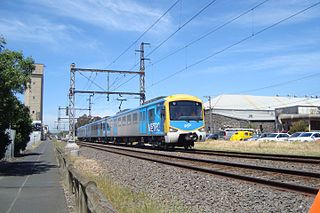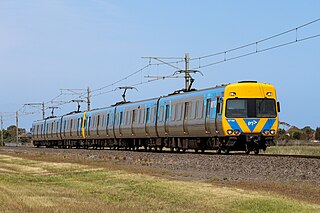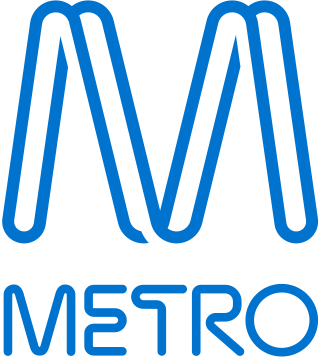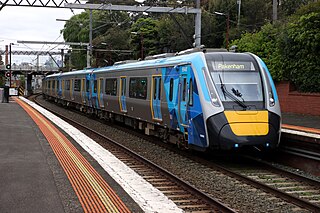The X'Trapolis is a series of multiple unit trains designed and built by Alstom. The trains have high floors, and are available in both single- and double-deck configurations. They are typically powered by an external electrical source, but may also be powered by batteries, hydrogen or diesel-electric power units.

Proposals for expansion of the Melbourne rail network are commonly presented by political parties, government agencies, industry organisations and public transport advocacy groups. The extensions proposed take a variety of forms: electrification of existing routes to incorporate them into the suburban rail system; reconstruction of former passenger rail lines along pre-existing easements; entirely new routes intended to serve new areas with heavy rail or provide alternative routes in congested areas; or track amplification along existing routes to provide segregation of services. Other proposals are for the construction of new or relocated stations on existing lines, to provide improved access to public transport services.

The Glen Waverley line is a commuter railway line in the city of Melbourne, Victoria, Australia. Operated by Metro Trains Melbourne, it is the city's sixth shortest metropolitan railway line at 21.3 kilometres (13.2 mi). The line runs from Flinders Street station in central Melbourne to Glen Waverley station in the east, serving 20 stations including Burnley, Kooyong, East Malvern, and Jordanville. The line operates for approximately 19 hours a day with 24 hour service available on Friday and Saturday nights. The line operates with headways of up to 10 minutes during peak hours and as long as 30 minutes during off-peak hours. Trains on the Glen Waverley line run with two three-car formations of X'Trapolis 100 trainsets.

The Frankston line is a commuter railway line in the city of Melbourne, Victoria, Australia. Operated by Metro Trains Melbourne, it is the city's third-longest metropolitan railway line, at 42.7 kilometres (26.5 mi). The line runs from Flinders Street station in central Melbourne to Frankston station in the south-east, serving 28 stations via South Yarra, Caulfield, Moorabbin, and Mordialloc. The line continues to Stony Point on the non-electrified Stony Point line. The line operates for approximately 20 hours a day with 24 hour service available on Friday and Saturday nights. During peak hour, headways of up to 5 to 10 minutes are operated with services every 10–20 minutes during off-peak hours. Trains on the Frankston line run with a two three-car formations of Comeng, Siemens Nexas, and X'Trapolis 100 trainsets.

The Pakenham line is a commuter railway line on the Melbourne metropolitan railway network serving the city of Melbourne in Victoria, Australia. Operated by Metro Trains Melbourne, the line is coloured light blue and is one of the two lines that constitute the Caulfield group. It is the city's longest metropolitan railway line at 57 kilometres (35 mi). The line runs from Flinders Street station in central Melbourne to East Pakenham station in the south-east, serving 27 stations via South Yarra, Caulfield, Oakleigh, and Dandenong.

The Sandringham line is a commuter railway line in the city of Melbourne, Victoria, Australia. Operated by Metro Trains Melbourne, it is the city's fourth shortest metropolitan railway line at 17.9 kilometres (11.1 mi). The line runs from Flinders Street station in central Melbourne to Sandringham station in the south-east, serving 14 stations via South Yarra, Balaclava, Elsternwick, and Brighton. The line operates from approximately 5am to 12am, daily, with 24 hour service available on Friday and Saturday nights. Services run every 7–8 minutes during peak hour, with services running every 15 minutes during the inter-peak period on weekdays, and every 20 minutes at night and during the day on weekends. Additionally, services run every 60 minutes overnight on Friday and Saturday nights as part of the Night Network. Trains on the Sandringham line run with a two three-car formations of Comeng or Siemens Nexas trainsets.

The Upfield line is a commuter railway line in the city of Melbourne, Victoria, Australia. Operated by Metro Trains Melbourne, it is the city's fifth-shortest metropolitan railway line at 20.1 kilometres (12.5 mi). The line runs from Flinders Street station in central Melbourne to Upfield station in the north, serving 19 stations via North Melbourne, Brunswick, Coburg, and Fawkner.

The Werribee line is a commuter railway line in the city of Melbourne, Victoria, Australia. Operated by Metro Trains Melbourne, it is the city's ninth longest metropolitan railway line at 32.9 kilometres (20.4 mi).

The Williamstown line is a commuter railway line in the city of Melbourne, Victoria, Australia. Operated by Metro Trains Melbourne, it is the city's third shortest metropolitan railway line at 16.2 kilometres (10.1 mi).

The Sunbury line is a commuter railway line in the city of Melbourne, Victoria, Australia. Operated by Metro Trains Melbourne, it is the city's fifth longest metropolitan railway line at 40.3 kilometres (25.0 mi). The line runs from Flinders Street station in central Melbourne to Sunbury station in the city's north-west, serving 18 stations via North Melbourne, Sunshine, St Albans, and Watergardens. The line operates for approximately 19 hours a day with 24 hour service available on Friday and Saturday nights. During peak hour, headways of up to 5 minutes are operated with services every 20–30 minutes during off-peak hours. Train sets typically used on the Sunbury line are the Comeng and Siemens Nexas trainsets and, for two morning peak services, the High Capacity Metro Train.

The Flemington Racecourse line is a commuter railway line in the city of Melbourne, Victoria, Australia. Operated by Metro Trains Melbourne, it is the city's shortest metropolitan railway line at 7.8 kilometres (4.8 mi). The line runs from Flinders Street station in central Melbourne to Flemington Racecourse station, situated next to the racecourse in the city's north west, serving a total of 5 stations. The line operates only during special events, with services as frequent as every 4 minutes during peak periods of those special events. Trains on the Flemington Racecourse line run with two three-car formations of Comeng, Siemens Nexas, or X'Trapolis 100 trainsets.

Connex Melbourne was a train operator in Melbourne, Australia. Formed in July 1998 as Hillside Trains, a business unit of the Public Transport Corporation, it was privatised in August 1999 becoming a subsidiary of Connex.

The Hitachi was an electric multiple unit train that operated on the Melbourne suburban railway network between 1972 and 2014. Electrical equipment was supplied by Commonwealth Engineering, to designs by Hitachi of Japan, leading to their official name today, although no Hitachi-supplied components were used in their construction. They were the last suburban trains in Melbourne without air conditioning. A total of 355 carriages were built between 1972 and 1981, including a replacement carriage for one written off while the fleet was still being delivered.

The Craigieburn line is a commuter railway line in the city of Melbourne, Victoria, Australia. Operated by Metro Trains Melbourne, it is the city's seventh shortest metropolitan railway line at 27.0 kilometres (16.8 mi). The line runs from Flinders Street station in central Melbourne to Craigieburn station in the north, serving 21 stations via North Melbourne, Essendon, and Broadmeadows. The line operates for approximately 19 hours a day with 24 hour service available on Friday and Saturday nights. During peak hour, headways of up to 5 minutes are operated with services every 20–30 minutes during off-peak hours. Trains on the Craigieburn line run with a two three-car formations of Comeng or Siemens Nexas trainsets.

The Comeng is a class of electric multiple unit (EMU) operating on the suburban railway network of Melbourne. Built by their namesake Commonwealth Engineering, the trains were introduced in 1981 as a replacement for the Tait and Harris trains. In total, 190 three-car trainsets were built, although only 115 remain in service and are expected to be retired by 2030.
The X'Trapolis 100 is a class of single deck electric multiple units part of Alstom's X'Trapolis family of trains, operated in Melbourne, Victoria, Australia and Valparaíso, Chile.
Ballarat North Workshops is a railway engineering facility owned by Alstom in Ballarat, Victoria, Australia. It occupies 5.5 hectares of land beside the junction of the Mildura and Serviceton railway lines.

Metro Trains Melbourne, often known simply as Metro, is the operator and brand name of train services on the electrified metropolitan rail network serving the city of Melbourne, Victoria, Australia. It is the largest urban rail network in Australia, with 17 lines and 221 stations across 405 km (252 mi) of railways, and the second busiest network in Australia, with a patronage of 99.5 million as of 2021–2022.

The Transperth C-series trains are a class of electric multiple units part of Alstom's X'Trapolis family of trains for Transperth that are being delivered as part of Metronet. The trains are operating on Perth's suburban rail network and entered service on the Yanchep and Mandurah lines on 8 April 2024.

The High Capacity Metro Train (HCMT) is a type of electric multiple unit (EMU) train for use by Metro Trains Melbourne on the Melbourne rail network. The first train set entered service on 27 December 2020 and will become the primary rolling stock used in the Metro Tunnel when it opens in 2025.



















